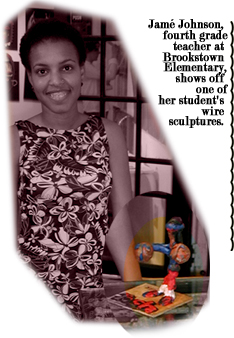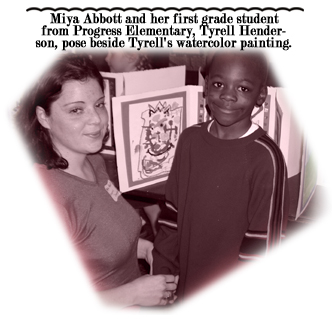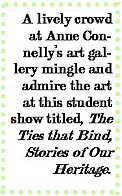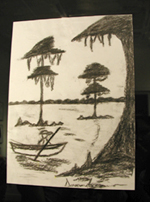|
 |
|
Teacher Spotlights: Teach for America, Karn Engesgjerd, Jamé C. Johnson, Joshua Gerber, Miya Abbott, East Baton Rouge Parish
by Nalini Raghavan
What do you get when you combine the power of the arts to engage a student and his or her multiple intelligences AND the ability of subject matter to connect with students' lives? You get a formula for student success, according to several Teach for America Corps members who participated in this year's arts-in education project titled, The Ties that Bind, Stories of Our Heritage.
Karn Engelsgjerd, was formerly Teach for America's Program director for South Louisiana, and a fourth grade teacher at Baton Rouge's Forest Heights Elementary. In 2000, her first year as a teacher in the public schools, she realized two things that prompted her to write a grant to the Arts Council of Greater Baton Rouge. First, she realized that her students were not getting enough positive press; she also felt that her students needed more exposure to the arts. So, she applied for a grant to produce an arts-in-education project that has since become an annual Teach for America production in Baton Rouge. Four years later, the project involves nine Teach for America corps members, representing several Baton Rouge schools and serving students from elementary to high school.
The foundation of each year's project lies in the theme and the selected artists. The theme, of course, serves to both determine and connect the subject matter of each classrooms' project and the artists determine the artistic medium or material. The participating teachers, usually second year Teach for America corps members, plan and write the grant themselves with the guidance of their program director, Karn Engelsgjerd.
Though none of the teachers are given any pre-project training, this is not really necessary as the selected artists are typically members of the Arts Council of Greater Baton Rouge's Artist Roster. The Roster is a list of artists that have been specially approved for work in a K-12 classroom setting. Most local art councils maintain such a list, and the Louisiana State Division of the Arts also has one. Thus, the artists themselves are armed with training on how to connect art to the classroom. Additionally, some of the teachers reported that their artist was careful to teach them the process from beginning to end so that they could replicate the art project year after year on their own.
In 2004, most of the artists came during the first nine weeks of school and worked anywhere from five to ten hours total with each of their assigned classrooms, spread out over the course of a few weeks. The focus upon family, community, and personal heritage was reflected through a variety of artistic media, from clay and wire sculpture to watercolor portraits to mask making. In each instance, the students were encouraged to choose personally relevant subjects upon which to focus their art project. And, in the meantime, the teachers snuck in the content and skills that needed to be covered. The curricular connections reported by just three of the nine teachers alone were measurement, writing and research skills, oral communication, historic figures, ecology, and biology.
Ms. Jamé C. Johnson had her fourth grade students practicing and applying their knowledge of measurement, considering geometry concepts such as symmetry, and concepts such as comparison and contrast. Ms. Johnson was amazed by the results. As she explained to me, she knew intellectually that art was an exceptional tool for teaching, that it had the ability to raise achievement scores, and that the ability to engage creatively in a topic would strengthen students'  approach to other areas of learning. However, knowing intellectually is very different from actually guiding students through the process and experiencing the results of that effort. Only in the application of the arts as a teaching strategy did she come to truly understand how relevant topics and multisensory approaches to learning can improve practical skills such as measurement and writing, verbal communication skills, cooperation, verbal reasoning, problem solving, and the understanding of abstract concepts such as compare and contrast. approach to other areas of learning. However, knowing intellectually is very different from actually guiding students through the process and experiencing the results of that effort. Only in the application of the arts as a teaching strategy did she come to truly understand how relevant topics and multisensory approaches to learning can improve practical skills such as measurement and writing, verbal communication skills, cooperation, verbal reasoning, problem solving, and the understanding of abstract concepts such as compare and contrast.
Ms. Johnson also felt that the project aided her students in a much more fundamental way. Predictably, both she and fellow fourth grade teacher, Joshua Gerber of Greenville Elementary, found that their students experienced high levels of frustration with the art projects. Often, the students' projects did not come out as they visualized them. In some cases, they were also faced with materials that were physically difficult to manipulate, such as the stiff wire that was used in Mr. Ronald Trahan's wire sculptures. However, the students worked through the process, aided by positive reinforcement from their artist mentors who taught that the personal vision of an artist can change and that YOUR idea and YOUR product is valuable in and of itself for its very uniqueness. And in this way, they gained an invaluable asset – confidence. As Ms. Johnson put it, this project showed her, "that part of the thing the students really need in order to be successful on the LEAP is to feel successful previously and to have confidence in their skills and their work."


Even at the first grade level, students are seen taking initiative and practicing self-direction. Miya Abbott, first grade teacher at Progress Elementary, was actually amazed at her students' ability to be self-guided. Ms. Abbott's first graders conducted their art project in the middle of Black History Month during which her class learned about 1 or 2 African American leaders, role models, and mentors per day. In order to reinforce the subject matter and to capitalize on student's personal interests, each child was instructed to choose an African American that they wanted to learn more about. With enormous enthusiasm, these first graders checked out biographies on their subjects and researched them on the Internet. They were then asked to visually represent what they had learned about these individuals through a watercolor "triptych." The triptych was composed of three panels; the first panel was a self-portrait, the second panel was a portrait of the researched individual, and the third panel was one showing the two interacting in some way. For instance, one student who chose to research Rosa Parks depicted her and Rosa Parks sitting together on a bus.
Also amazing to Ms. Abbott was the level of attention that her class' artist, Susan Winguard, was able to capture. For over an hour at a time, her students were on task – a remarkable feat for her 6 and 7 year olds. And interestingly, her students were also incredibly impressed that she was able to get a professional artist to come to their class because they did not even know that artists were real people!
Ms. Abbott's first graders'response to the project was "overwhelmingly positive." They are extremely proud of their work and eager to take their paintings home, although Ms. Abbott reports that they do ask who is going to buy their paintings. A few years ago, Southern University bought a mural from one of the classes, and each student received $200. As much as they love their work, she supposes if a $200 offer was on the table, her students would not turn it down!
 Ms. Abbott has applied art strategies to other areas of her teaching since her involvement with this project. She has discovered that watercolor painting offers a great way to assess her students' understanding of a subject. For instance, she has since tested her students' understanding of insect anatomy by having them paint a picture, an approach that works very well since, at this age, they can much more easily represent something visually than they can in written or verbal form. Ms. Abbott has applied art strategies to other areas of her teaching since her involvement with this project. She has discovered that watercolor painting offers a great way to assess her students' understanding of a subject. For instance, she has since tested her students' understanding of insect anatomy by having them paint a picture, an approach that works very well since, at this age, they can much more easily represent something visually than they can in written or verbal form.
The focus on topics that are personally relevant to the student (i.e. community, neighborhood, family, personal history) was identified by all of the teachers interviewed as a primary component in keeping the students engaged in learning. When the topic is relevant and personally reflective, the student is much more invested in the quality of his/her work.
Joshua Gerber's 4th graders completed a family tree with the help of parents and other family members. This simple exercise, tied to 4th grade Social Studies standards, serves as a theme around which to build skills lessons. The first step was to create a genealogy chart, mapping out their family history in a flow chart format of a family genealogy. Guided by class artist Abby Salazar, they then visually represented this family tree through a multimedia poster. The family tree idea is not a new one for teachers, but what probably made the difference for the students was the novel and unique representation of their family tree research through an artistic medium. Also, the promise of time with their artist mentor served as a powerful incentive to attend to their work – whether related to the art project or not.
Mr. Gerber has plans to capitalize on his students' investment in this art project by building future lessons on it. The students have been practicing their interviewing and note taking skills with one another in the classroom in anticipation of interviewing a family member on whom they are going to write a biography. Thus, Mr. Gerber has built many skills writing process, grammar, spelling, primary research, communication and listening skills, etc.- upon this one theme.
 
 The public nature of this Teach for America art-in-education model is an essential component of its success; every year, these art projects culminate in public art openings at professional art galleries. The first show featured in this article took place at Anne Connelly's and the second show will be held at Southern University. Such public expositions provide positive press for these students and offer an enormous incentive to invest in their own learning (whether they know it or not!). The public nature of this Teach for America art-in-education model is an essential component of its success; every year, these art projects culminate in public art openings at professional art galleries. The first show featured in this article took place at Anne Connelly's and the second show will be held at Southern University. Such public expositions provide positive press for these students and offer an enormous incentive to invest in their own learning (whether they know it or not!).
The participating teachers organized the art show, from coordinating with the gallery owners to framing and hanging the art works to writing press releases. With nine teachers cooperating in this effort, the work load was manageable and the end result was a very professional art opening. As family members took pictures of their little artist next to his or her work and as newspaper reporters interviewed them and took their pictures, it was evident that these students valued the finished products that came out of this art project and that, in anticipation of a public showing, the students tried their absolute best.
Though many teachers can relate to Mr. Gerber's comment to me that his first year of teaching "was and still is the most difficult thing I've ever done in my life," they can also relate to the tremendous rewards garnered through the successful completion of projects such as this. You know you are doing something right, as these Teach for America teachers are, when a student writes on a survey that, "I loved Mr. Trahan [her class artist] and he taught me how to do things that I never thought I could do."
Next Teacher Spotlight
|

